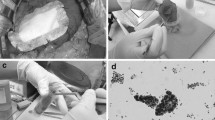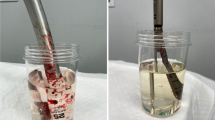Abstract
Background
Manipulation and improper handling of a tumor during surgery may increase the risk of cancer cell dissemination after a curative gastrectomy. This study investigated the effect of improper handling of lymphovascular pedicles of stomach on tumor spillage during surgical procedure.
Methods
Thirty-eight gastric cancer patients were enrolled. Three pairs of wash samples were obtained from each patient: (1) intraperitoneal wash samples obtained before (P0) and after gastrectomy (P1), (2) intragastric wash samples obtained before any manipulation (G0) and just before resection of the stomach (G1), and (3) ex vivo wash samples obtained by rinsing resected stomach with the lymphovascular pedicles closed by clips (S0) or with the pedicles open (S1). Cytologic examination was performed from all washes, and real-time reverse transcriptase–polymerase chain reaction analysis for carcinoembryonic antigen was performed from washes P0, P1, S0, and S1.
Results
Cytologic examination detected cancer cells in 34.2% (13 of 38) of G0 samples and in 39.5% (15 of 38) of G1 samples. The rate of conversion from G0-negative to G1-positive increased as T stage increased. Cytologic examination detected cancer cells in 2.6% (1 of 38) of S0 samples and in 13.2% (5 of 38) of S1 samples. The carcinoembryonic antigen mRNA level of the S1 sample was 2-fold greater than that of the S0 sample in 50.0% (7 of 14).
Conclusions
Free cancer cells can be released from gastric lumen or lymphovascular pedicles opened during gastric cancer surgery, especially in advanced-stage disease. Care should be taken to minimize spillage from the gastric lumen and lymphovascular pedicles.


Similar content being viewed by others
References
Moriguchi S, Maehara Y, Korenaga D, et al. The relationship between prognostic-significance of pathological type and the degree of gastric wall invasion in gastric-cancer. Cancer J. 1992;5:220–3.
Iriyama K, Miki C, Kitagawa T. Influence of tumour penetration on period of death after gastric cancer surgery. Br J Surg. 1997;84:866–7.
Noguchi Y. Blood vessel invasion in gastric carcinoma. Surgery. 1990;107:140–8.
Ikeguchi M, Katano K, Oka A, et al. Relationship between hematogenic metastasis of gastric cancer and the maximum extent of venous invasion by cancer cells in the gastric wall. Hepatogastroenterology. 1995;42:660–5.
Maehara Y, Oshiro T, Baba H, et al. Lymphatic invasion and potential for tumor growth and metastasis in patients with gastric cancer. Surgery. 1995;117:380–5.
Maehara Y, Hasuda S, Koga T, et al. Postoperative outcome and sites of recurrence in patients following curative resection of gastric cancer. Br J Surg. 2000;87:353–7.
Schwarz RE, Zagala-Nevarez K. Recurrence patterns after radical gastrectomy for gastric cancer: prognostic factors and implications for postoperative adjuvant therapy. Ann Surg Oncol. 2002;9:394–400.
Roviello F, Marrelli D, de Manzoni G, et al. Prospective study of peritoneal recurrence after curative surgery for gastric cancer. Br J Surg. 2003;90:1113–9.
Lee HJ, Kim YH, Kim WH, et al. Clinicopathological analysis for recurrence of early gastric cancer. Jpn J Clin Oncol. 2003;33:209–14.
Ichiyoshi Y, Toda T, Minamisono Y, et al. Recurrence in early gastric cancer. Surgery. 1990;107:489–95.
Marutsuka T, Shimada S, Shiomori K, et al. Mechanisms of peritoneal metastasis after operation for non-serosa-invasive gastric carcinoma: an ultrarapid detection system for intraperitoneal free cancer cells and a prophylactic strategy for peritoneal metastasis. Clin Cancer Res. 2003;9:678–85.
Boku T, Nakane Y, Minoura T, et al. Prognostic significance of serosal invasion and free intraperitoneal cancer cells in gastric cancer. Br J Surg. 1990;77:436–9.
Bonenkamp JJ, Songun I, Hermans J, et al. Prognostic value of positive cytology findings from abdominal washings in patients with gastric cancer. Br J Surg. 1996;83:672–4.
Kodera Y, Yamamura Y, Shimizu Y, et al. Peritoneal washing cytology: prognostic value of positive findings in patients with gastric carcinoma undergoing a potentially curative resection. J Surg Oncol. 1999;72:60–4.
Homma Y, Ushida S, Yamada M, et al. Positive peritoneal washing cytology in multiple cavities can predict poor prognosis of advanced gastric cancer patients. Ann Surg Oncol. 2010;17:455–60.
Hase K, Ueno H, Kuranaga N, et al. Intraperitoneal exfoliated cancer cells in patients with colorectal cancer. Dis Colon Rectum. 1998;41:1134–40.
Doki Y, Kabuto T, Ishikawa O, et al. Does pleural lavage cytology before thoracic closure predict both patient’s prognosis and site of cancer recurrence after resection of esophageal cancer. Surgery. 2001;130:792–7.
Abe S, Yoshimura H, Tabara H, et al. Curative resection of gastric cancer: limitation of peritoneal lavage cytology in predicting the outcome. J Surg Oncol. 1995;59:226–9.
Cetin B, Atalay C, Aslan S, et al. Peritoneal carcinoembryonic antigen level for predicting locoregional and distant spread of gastric cancer. Surg Today. 2005;35:919–24.
Li JK, Zheng M, Miao CW, et al. Peritoneal lavage cytology and carcinoembryonic antigen determination in predicting peritoneal metastasis and prognosis of gastric cancer. World J Gastroenterol. 2005;11:7374–7.
Suzuki T, Ochiai T, Hayashi H, et al. Peritoneal lavage cytology findings as prognostic factor for gastric cancer. Semin Surg Oncol. 1999;17:103–7.
Bando E, Yonemura Y, Takeshita Y, et al. Intraoperative lavage for cytological examination in 1,297 patients with gastric carcinoma. Am J Surg. 1999;178:256–62.
Kodera Y, Nakanishi H, Ito S, et al. Prognostic significance of intraperitoneal cancer cells in gastric carcinoma: analysis of real time reverse transcriptase–polymerase chain reaction after 5 years of followup. J Am Coll Surg. 2006;202:231–6.
Tamura N, Iinuma H, Takada T. Prospective study of the quantitative carcinoembryonic antigen and cytokeratin 20 mRNA detection in peritoneal washes to predict peritoneal recurrence in gastric carcinoma patients. Oncol Rep. 2007;17:667–72.
Yonemura Y, Fujimura T, Ninomiya I, et al. Prediction of peritoneal micrometastasis by peritoneal lavaged cytology and reverse transcriptase–polymerase chain reaction for matrix metalloproteinase-7 mRNA. Clin Cancer Res. 2001;7:1647–53.
Sakakura C, Takemura M, Hagiwara A, et al. Overexpression of dopa decarboxylase in peritoneal dissemination of gastric cancer and its potential as a novel marker for the detection of peritoneal micrometastases with real-time RT-PCR. Br J Cancer. 2004;90:665–71.
Shimomura K, Sakakura C, Takemura M, et al. Combination of l-3-phosphoserine phosphatase and CEA using real-time RT-PCR improves accuracy in detection of peritoneal micrometastasis of gastric cancer. Anticancer Res. 2004;24:1113–20.
Nakanishi H, Kodera Y, Torii A, et al. Detection of carcinoembryonic antigen-expressing free tumor cells in peritoneal washes from patients with gastric carcinoma by polymerase chain reaction. Jpn J Cancer Res. 1997;88:687–92.
Wang Z, Zhang X, Xu H, et al. Detection of peritoneal micrometastasis by reverse transcriptase–polymerase chain reaction for heparanase mRNA and cytology in peritoneal wash samples. J Surg Oncol. 2005;90:59–65.
Fujiwara Y, Doki Y, Taniguchi H, et al. Genetic detection of free cancer cells in the peritoneal cavity of the patient with gastric cancer: present status and future perspectives. Gastric Cancer. 2007;10:197–204.
Miyazono F, Natsugoe S, Takao S, et al. Surgical maneuvers enhance molecular detection of circulating tumor cells during gastric cancer surgery. Ann Surg. 2001;233:189–94.
Japanese Gastric Cancer A. Japanese classification of gastric carcinoma. 2nd English ed. Gastric Cancer. 1998;1:10–24.
Greene FL, American Joint Committee on Cancer., American Cancer Society. AJCC cancer staging manual. 6th ed. New York: Springer-Verlag; 2002.
Shimada S, Tanaka E, Marutsuka T, et al. Extensive intraoperative peritoneal lavage and chemotherapy for gastric cancer patients with peritoneal free cancer cells. Gastric Cancer. 2002;5:168–72.
Kuramoto M, Shimada S, Ikeshima S, et al. Extensive intraoperative peritoneal lavage as a standard prophylactic strategy for peritoneal recurrence in patients with gastric carcinoma. Ann Surg. 2009;250:242–6.
Kodera Y, Nakanishi H, Yamamura Y, et al. Prognostic value and clinical implications of disseminated cancer cells in the peritoneal cavity detected by reverse transcriptase–polymerase chain reaction and cytology. Int J Cancer. 1998;79:429–33.
Nakanishi H, Kodera Y, Yamamura Y, et al. Rapid quantitative detection of carcinoembryonic antigen-expressing free tumor cells in the peritoneal cavity of gastric-cancer patients with real-time RT-PCR on the lightcycler. Int J Cancer. 2000;89:411–7.
Acknowledgment
This study was supported by a grant from the Seoul National University College of Medicine Research Fund (06-2007-2829), which was a donation from Heung Soon Park. The authors would like to thank Dr. Cristina Ferrone for her review.
Author information
Authors and Affiliations
Corresponding author
Rights and permissions
About this article
Cite this article
Han, TS., Kong, SH., Lee, HJ. et al. Dissemination of Free Cancer Cells from the Gastric Lumen and from Perigastric Lymphovascular Pedicles during Radical Gastric Cancer Surgery. Ann Surg Oncol 18, 2818–2825 (2011). https://doi.org/10.1245/s10434-011-1620-8
Received:
Published:
Issue Date:
DOI: https://doi.org/10.1245/s10434-011-1620-8




